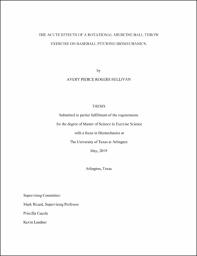
ATTENTION: The works hosted here are being migrated to a new repository that will consolidate resources, improve discoverability, and better show UTA's research impact on the global community. We will update authors as the migration progresses. Please see MavMatrix for more information.
Show simple item record
| dc.contributor.advisor | Ricard, Mark D. | |
| dc.creator | Rogers Sullivan, Avery Pierce | |
| dc.date.accessioned | 2019-06-13T17:49:19Z | |
| dc.date.available | 2019-06-13T17:49:19Z | |
| dc.date.created | 2019-05 | |
| dc.date.issued | 2019-06-03 | |
| dc.date.submitted | May 2019 | |
| dc.identifier.uri | http://hdl.handle.net/10106/28210 | |
| dc.description.abstract | The ability to throw at higher velocities with proper mechanics is very advantageous for baseball
pitchers to increase performance and decrease injury risk. Pitching utilizes the movement of
energy through the kinetic chain, wherein momentum is generated by the proximal core
segments of the body and transferred to the distal segments of the throwing shoulder and elbow
to produce ball velocity. Medicine ball throws (MBT) have been used as a training method for
rotational throwing and striking athletes to improve core strength and power. Rotational MBT
are sport-specific for baseball pitching because of the similar explosive sequential muscle
activation of the pelvis, torso, and arms. The purpose of this study was to investigate the effects
of a side-rotational MBT exercise on pitching biomechanics and ball velocity when performed
immediately prior to pitching as a method of post-activation potentiation (PAP). High school,
college, and professional aged pitchers (n = 6, age 19.5 ± 3.6 years) were randomly assigned to
MBT and control (CON) groups. Both groups threw five pre-trial and five post-trial maximal
effort fastballs, with the MBT group performing one set of six side-rotational MBT at maximum
effort in between the pre and post-trials while the CON group rested. All pitching trials were recorded by a three-dimensional motion capture system at 240 Hz, from which five temporal,
four kinematic, and three kinetic variables were calculated. A 2 x 2 mixed ANOVA for each
dependent variable was used for comparisons between and within groups. There were significant
interactions between groups and time for peak trunk rotational velocity (p = .049), peak elbow
extension velocity (p = .014), and maximum external rotation torque (p = .042). These results
may warrant further research into MBT as a method for warming up and eliciting a PAP
response for pitching. | |
| dc.format.mimetype | application/pdf | |
| dc.language.iso | en_US | |
| dc.subject | Baseball | |
| dc.subject | Pitching | |
| dc.subject | Biomechanics | |
| dc.subject | Velocity | |
| dc.subject | Activation | |
| dc.subject | Potentiation | |
| dc.subject | Medicine | |
| dc.subject | Ball | |
| dc.subject | Throw | |
| dc.subject | Exercise | |
| dc.subject | Warm-up | |
| dc.title | The acute effects of a rotational medicine ball throw exercise on baseball pitching biomechanics | |
| dc.type | Thesis | |
| dc.degree.department | Kinesiology | |
| dc.degree.name | Master of Science in Exercise Science | |
| dc.date.updated | 2019-06-13T17:49:20Z | |
| thesis.degree.department | Kinesiology | |
| thesis.degree.grantor | The University of Texas at Arlington | |
| thesis.degree.level | Masters | |
| thesis.degree.name | Master of Science in Exercise Science | |
| dc.type.material | text | |
| dc.creator.orcid | 0000-0002-6110-0000 | |
Files in this item
- Name:
- ROGERSSULLIVAN-THESIS-2019.pdf
- Size:
- 2.313Mb
- Format:
- PDF
This item appears in the following Collection(s)
Show simple item record


